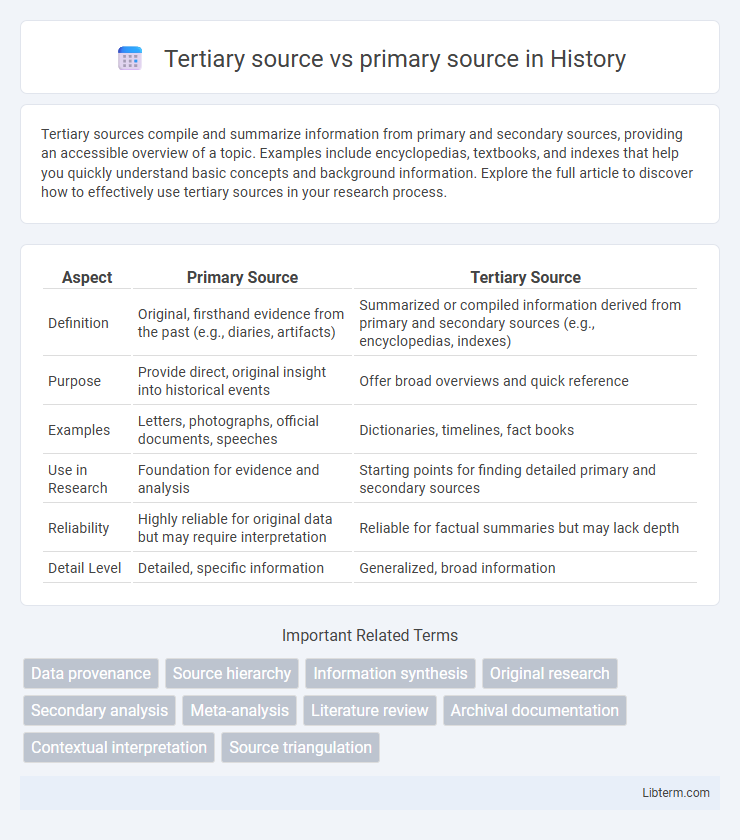Tertiary sources compile and summarize information from primary and secondary sources, providing an accessible overview of a topic. Examples include encyclopedias, textbooks, and indexes that help you quickly understand basic concepts and background information. Explore the full article to discover how to effectively use tertiary sources in your research process.
Table of Comparison
| Aspect | Primary Source | Tertiary Source |
|---|---|---|
| Definition | Original, firsthand evidence from the past (e.g., diaries, artifacts) | Summarized or compiled information derived from primary and secondary sources (e.g., encyclopedias, indexes) |
| Purpose | Provide direct, original insight into historical events | Offer broad overviews and quick reference |
| Examples | Letters, photographs, official documents, speeches | Dictionaries, timelines, fact books |
| Use in Research | Foundation for evidence and analysis | Starting points for finding detailed primary and secondary sources |
| Reliability | Highly reliable for original data but may require interpretation | Reliable for factual summaries but may lack depth |
| Detail Level | Detailed, specific information | Generalized, broad information |
Introduction to Information Sources
Primary sources provide original, first-hand evidence or direct data related to a topic, such as diaries, interviews, or experimental results. Tertiary sources compile and summarize information from primary and secondary sources, including encyclopedias, databases, and textbooks. Understanding the distinction between tertiary and primary sources is essential for evaluating the credibility and depth of information in research and academic work.
Defining Primary Sources
Primary sources are original, firsthand documents or evidence directly related to a specific topic or event, such as diaries, photographs, interviews, or official records. They provide unfiltered access to the subject matter, allowing researchers to analyze and interpret original data or firsthand accounts. Tertiary sources, by contrast, summarize or compile information from primary and secondary sources, lacking the direct, original evidence found in primary materials.
Understanding Tertiary Sources
Tertiary sources compile and summarize information from primary and secondary sources, offering an overview rather than original data or detailed analysis. Common examples include encyclopedias, indexes, fact books, and textbooks, which provide consolidated knowledge ideal for initial research or broad understanding. Unlike primary sources, which present firsthand evidence, or secondary sources, which interpret primary data, tertiary sources serve as reference tools to locate and contextualize information efficiently.
Key Differences Between Primary and Tertiary Sources
Primary sources provide original, firsthand evidence or direct data related to a topic, such as diaries, interviews, or experimental results. Tertiary sources compile and summarize information from primary and secondary sources, including encyclopedias, textbooks, and databases. The key difference lies in originality and purpose: primary sources offer raw, uninterpreted data, while tertiary sources serve as reference tools that organize and distill information for quick overview and accessibility.
Examples of Primary Sources
Manuscripts, eyewitness accounts, and original research articles exemplify primary sources, providing firsthand evidence or direct data from the event or topic studied. Diaries, speeches, and official documents such as birth certificates or legal contracts further illustrate primary sources, offering unfiltered insight into historical or contemporary subjects. Photographs, audio recordings, and raw statistical data also serve as primary sources, essential for original analysis in academic research or historical inquiry.
Examples of Tertiary Sources
Tertiary sources compile and summarize information from primary and secondary sources, offering an overview of a topic. Examples of tertiary sources include encyclopedias, dictionaries, almanacs, and fact books, which provide consolidated and easily accessible data. These sources are valuable for quick reference and background information but lack original research or in-depth analysis.
When to Use Primary vs. Tertiary Sources
Primary sources provide original, firsthand evidence crucial for in-depth research, detailed analysis, or when accuracy is paramount in fields like history, science, and law. Tertiary sources summarize and synthesize information from primary and secondary materials, making them ideal for quick reference, initial familiarization with a topic, or broad overviews. Use primary sources when verifying facts or conducting original research and rely on tertiary sources for general understanding or locating primary source references efficiently.
Advantages of Using Primary Sources
Primary sources offer direct, unfiltered access to original data, events, or firsthand accounts, enhancing the authenticity and accuracy of research. Utilizing primary sources enables in-depth analysis and unique insights that secondary or tertiary sources may overlook or generalize. Researchers relying on primary materials benefit from a rich contextual understanding, authenticity, and the ability to verify facts directly from the origin.
Advantages of Using Tertiary Sources
Tertiary sources offer the advantage of summarizing and consolidating information from multiple primary and secondary sources, making them efficient tools for quick reference and overviews. They provide organized and simplified content that helps users grasp key concepts without sifting through extensive original research or complex analyses. Their curated nature reduces the risk of misinterpretation, ensuring reliable guidance in preliminary research and study.
Conclusion: Choosing the Right Source
Selecting the right source depends on the research objective: primary sources provide original, firsthand evidence essential for in-depth analysis, while tertiary sources offer summarized and condensed information useful for quick reference and broad overviews. Understanding the reliability, purpose, and scope of each source type ensures accurate and efficient information gathering. Researchers should prioritize primary sources for authenticity and detailed insight, resorting to tertiary sources for initial familiarization or general background.
Tertiary source Infographic

 libterm.com
libterm.com